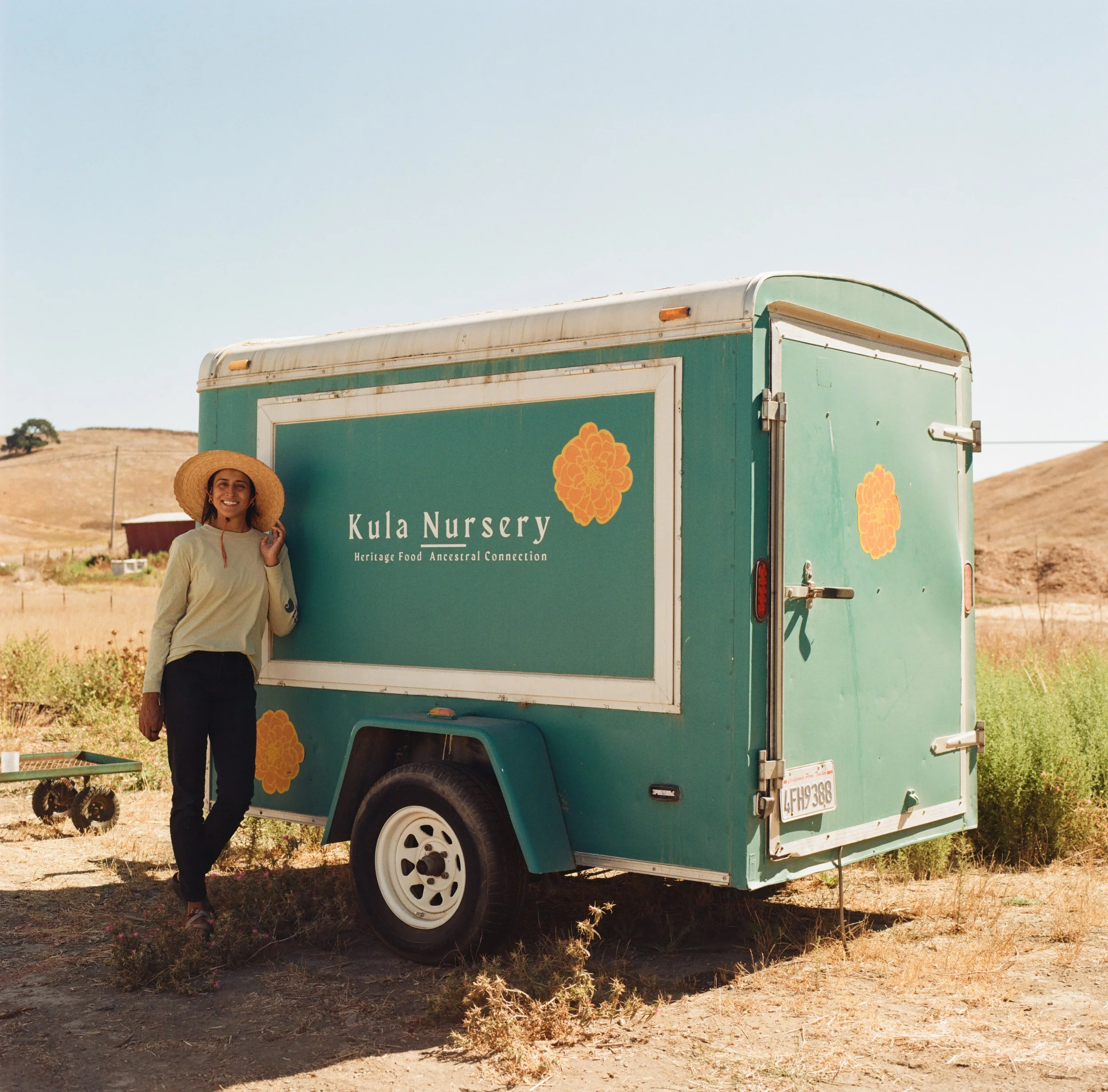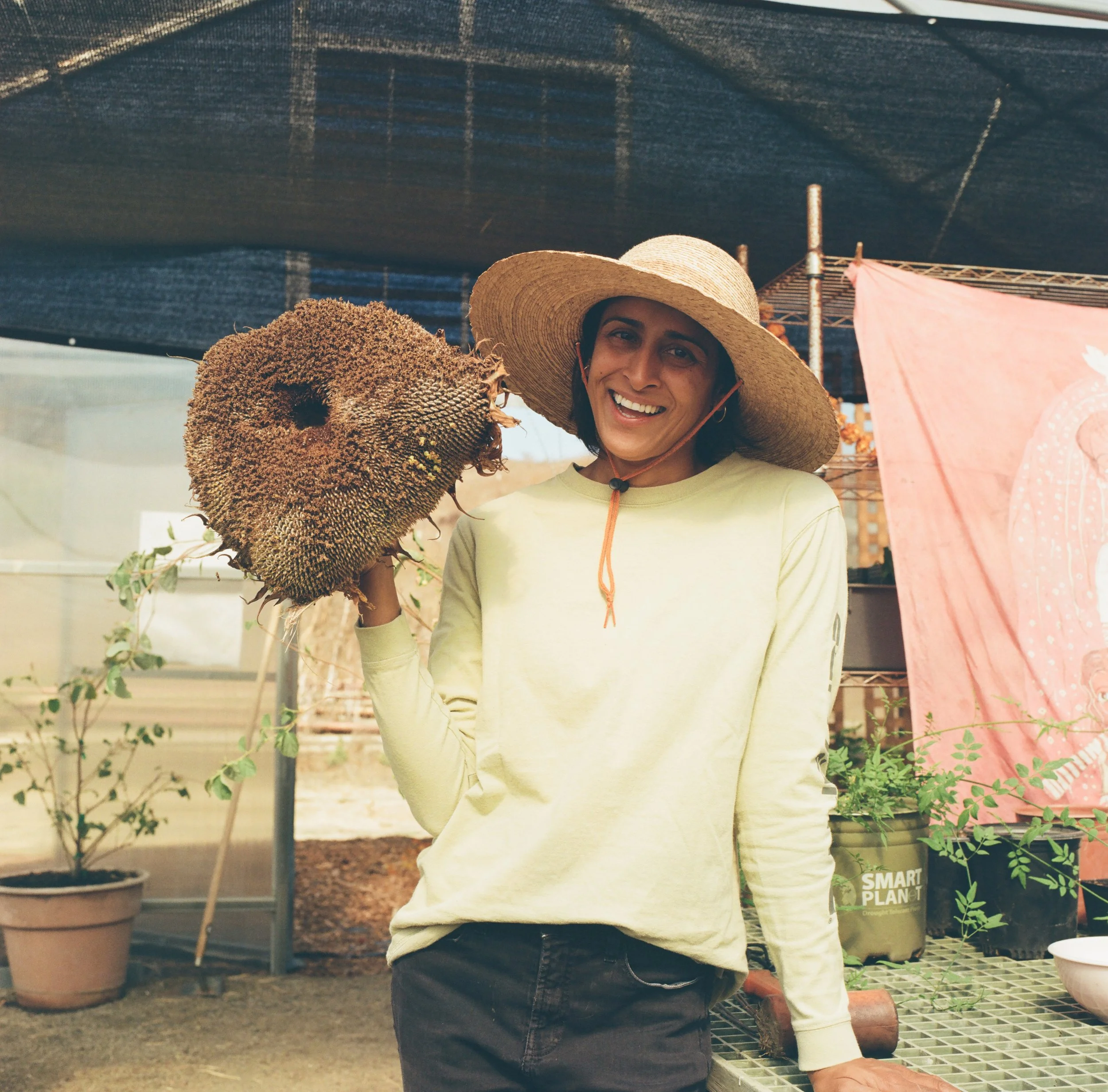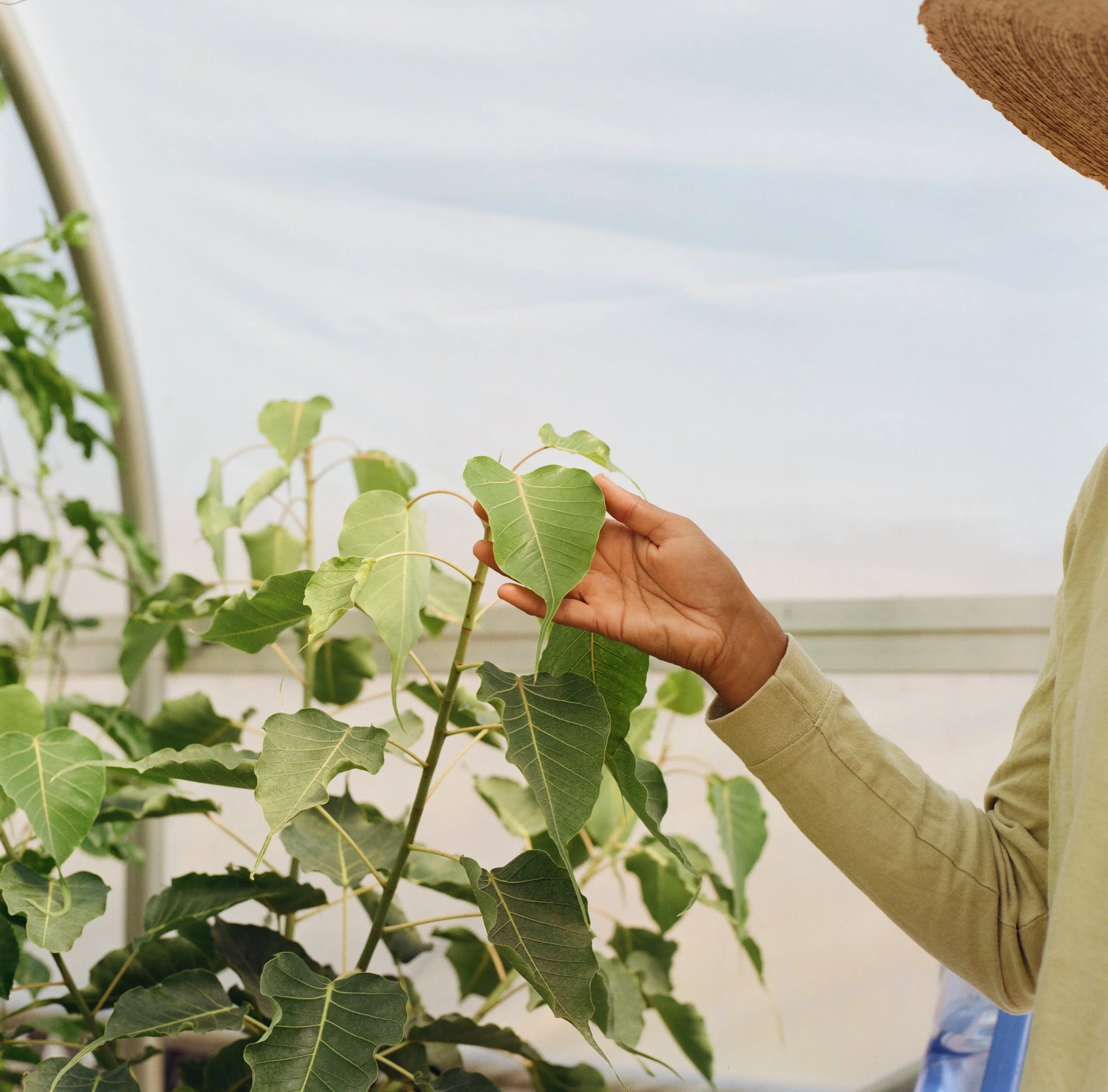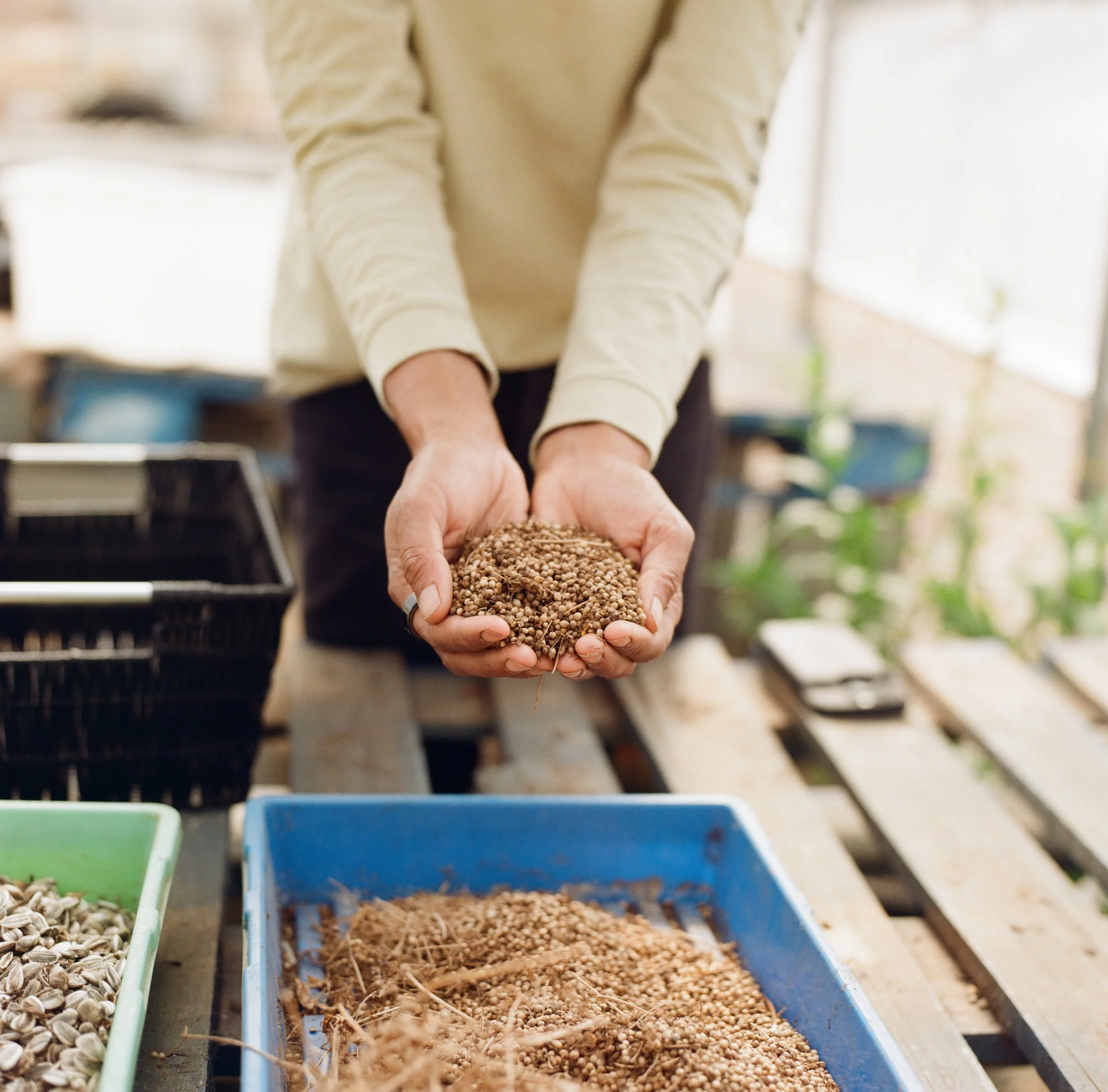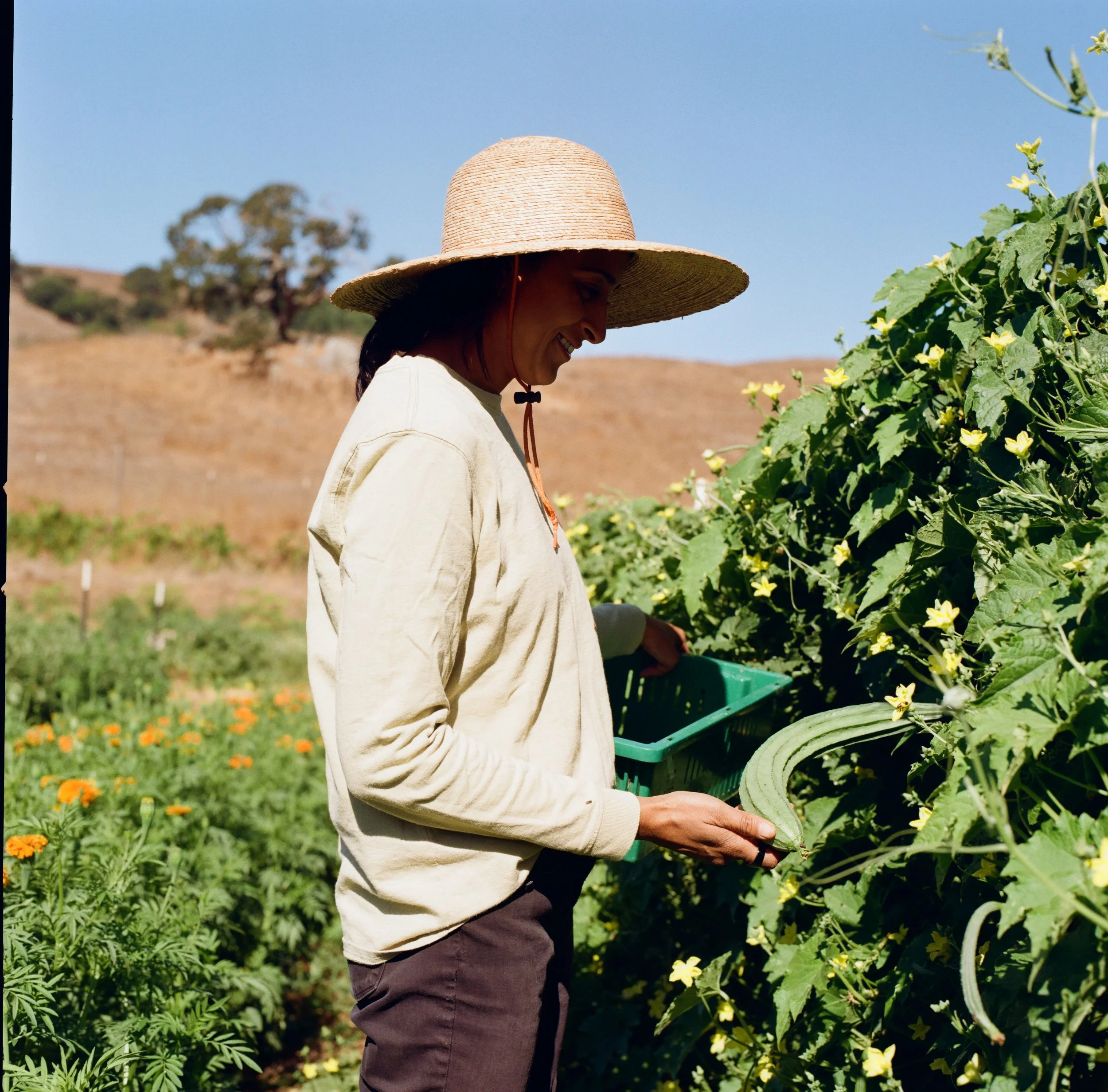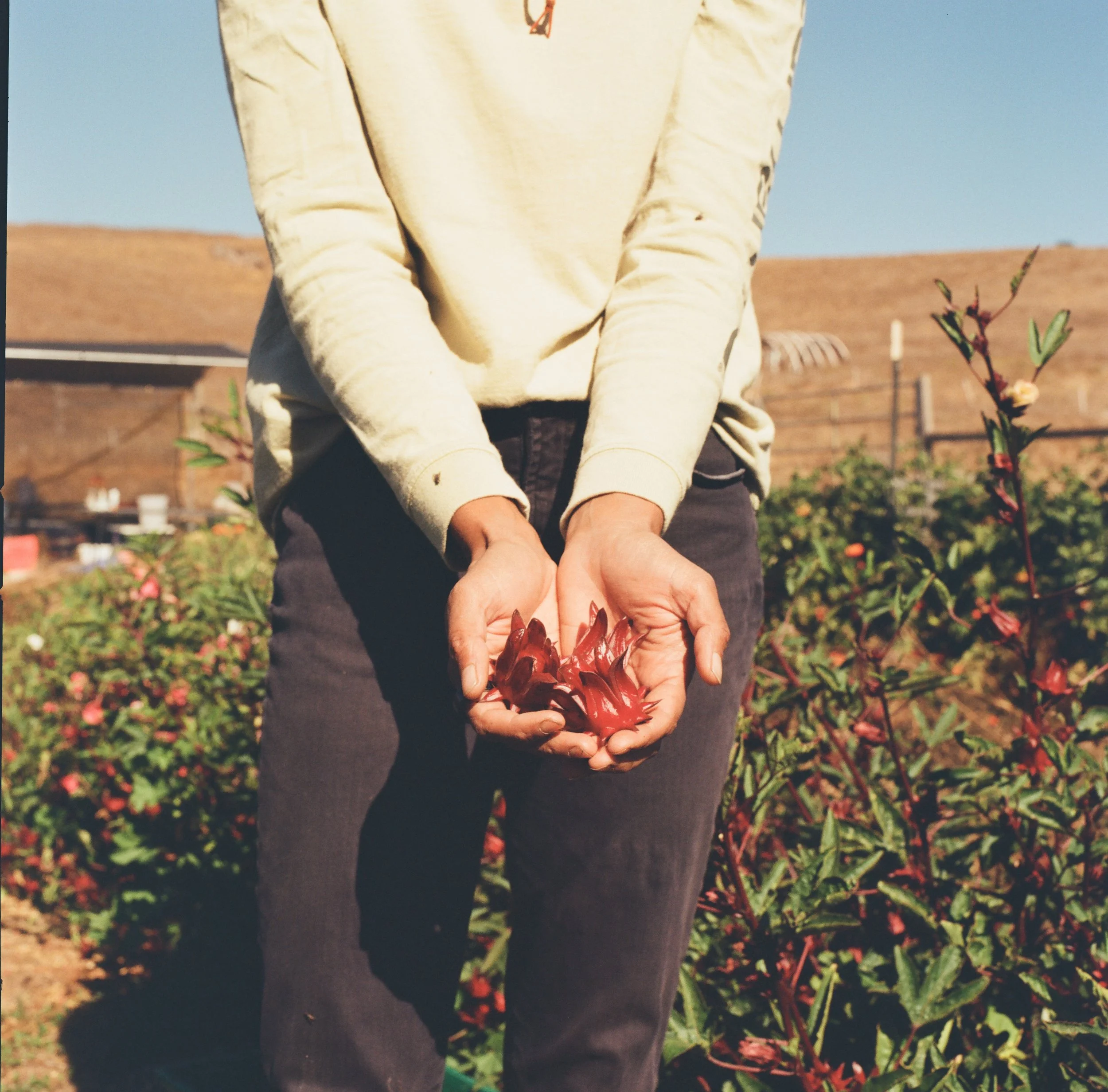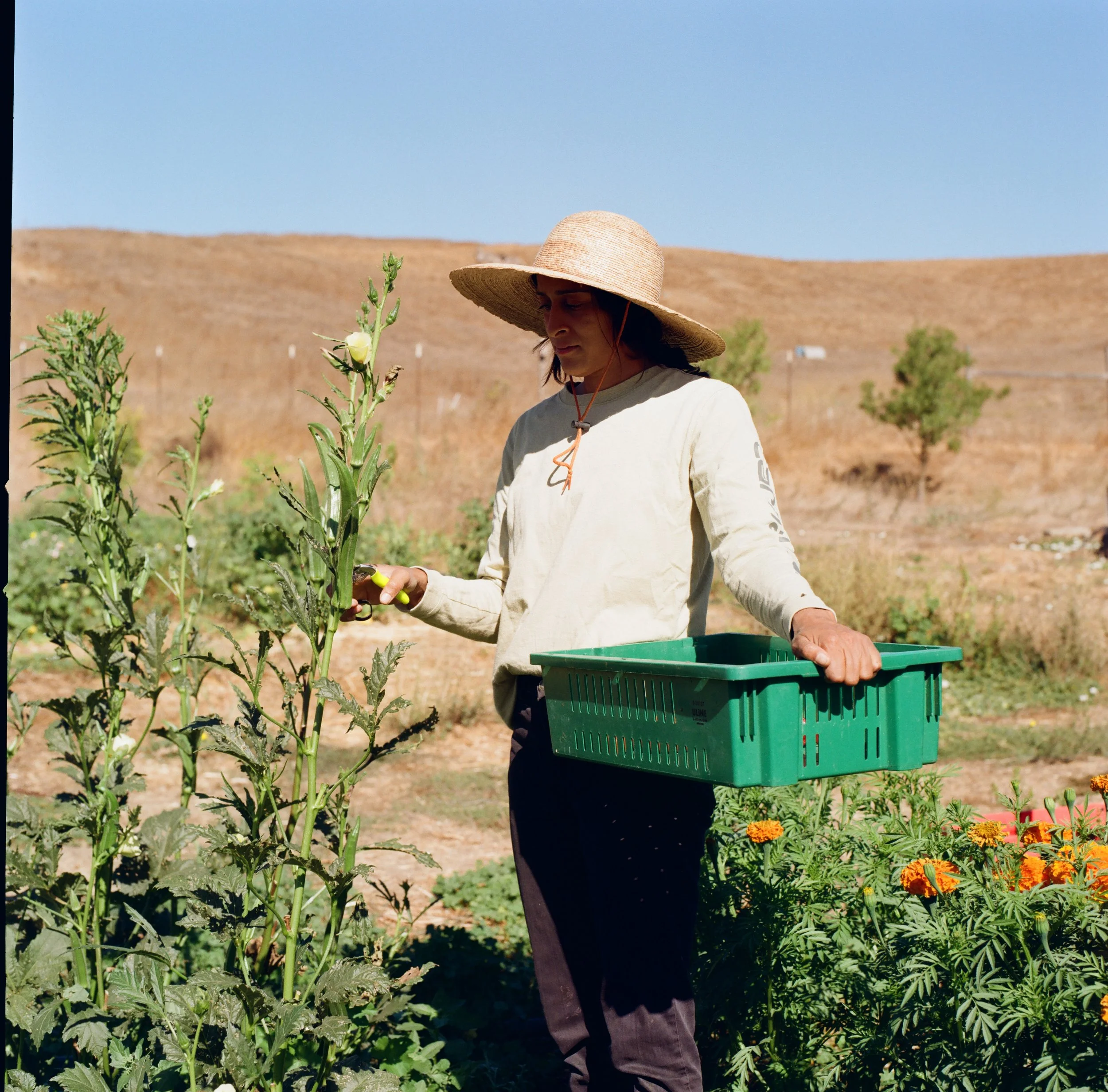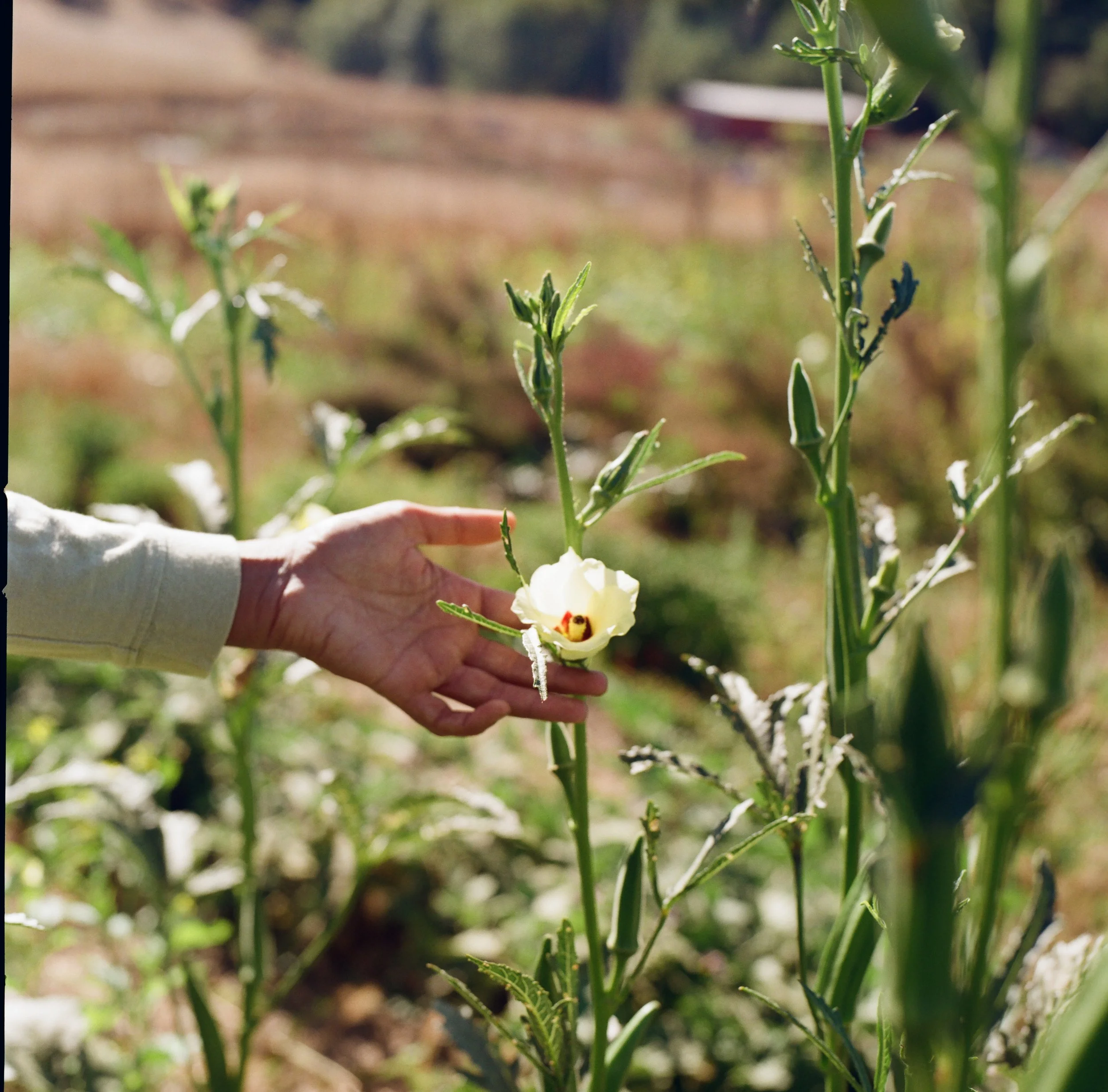Heritage Crops with Zee of Kula Nursery
Analog photos shot on Hasselblad 500c/m using Kodak Gold 200 film
Zee grew up with a single mother in a South Asian household, raised between her mom and grandparents. The convenience of having her grandparents as neighbors meant that she would go over to their house after school. She would sit with her grandma, make lunch, and they would eat Gujarati food together. Some of her best memories as a child were sitting with her grandma rolling out Roti, a family tradition that was a big influence in her youth.
Zee’s grandmother always had a green thumb and remembers her small patio full of perfect plants. She taught Zee how to grow Taro, which is what inspired the logo for Kula Nursery. Zee’s grandma would ask her to come home at sunset because she would play outside all day and wouldn’t come back until after dark. Nature and the outdoors were always a constant in her life.
Zee attended UC Irvine, where she studied Civil Engineering, and enjoyed all the water-like engineering aspects of her undergraduate degree. She was a Hydrologist for a couple of years after graduating from college, but quickly grew tired of sitting at a desk all day, not being fulfilled by her role as an engineer. Wanting to figure out what she wanted to do next, Zee quit her job and decided to travel through South America on her own, at age twenty-four, for what was only supposed to be three months.
Zee flew down the southern tip of Chile, where she met a group of friends and ended up joining them on their trip volunteering on farms abroad, similar to WWOOF-ing or Worldwide Opportunities on Organic Farms. During this period in her early twenties, she found herself saying yes to life. She spent five weeks in Chile growing vegetables, building food forests, and helping with water design on the farm - putting her undergraduate knowledge and experience to good use while still getting to be outdoors. This was a pivotal moment for her entry into agriculture.
Her three-month backpacking trip ended up extending to nine months as Zee was intentionally looking for more farm stays that could use her water skills. She interned on another farm in Peru, located in the northern Amazon basin, where she helped set up a water filtration system on a farm that had a river running through the property. Zee helped design it, and together, they built it.
After working on various farms in South America, and at the age of twenty-five, Zee decided to apply for her master’s. She attended UC Davis and received her Master’s in International Agricultural Development, a two-and-a-half-year program that allowed her to revisit Peru for her thesis research on food security issues amongst women in the Andes. Peruvians love their potatoes, and unfortunately, potatoes don’t have a lot of nutrients in them, especially if the soil is depleted. Zee found that many of the childbearing women who breastfeed their babies were not passing on enough nutrients to them, most significantly iron.
After coming back from Peru, Zee worked for UC Davis and farm worker communities in the Central Valley, where she focused on qualitative research and policy. Simultaneously, she was finishing her own research in Peru and writing her graduate thesis. Not long after, she was offered a full-time position with UC Davis and was ready to sign the contract on April 1st, 2020, when the research position was put on pause indefinitely due to COVID. At this point, Zee was living in Davis with a big backyard, gardening to her heart’s content. Many people took up gardening as a popular hobby during the pandemic, and she was asked to grow plant starts for a native plant nursery due to the high demand for vegetable starts.
Initially, Zee was just growing tomatoes and bell peppers; the typical things other nurseries sold. In her own backyard, however, she was growing Okra, Amaranth, Mallow, and many other heritage vegetables. The inspiration came when her mom and grandma were in disbelief that all of these heritage crops could be grown in California. They had not seen Amaranth in twenty-five years since coming to the U.S., and remembered making curry every Friday night with Amaranth leaves. This made Zee go on a quest to track down seeds that were not so readily available here.
That Fall, as the world had shut down, Zee spent a lot of time with her grandma in conversation about familiar vegetables growing up in India. Inspired by her ancestry and her love of growing plant starts from seed, she decided to go all in. The following year, she drove to different farmers markets in the San Francisco Bay Area to see which one she connected with the most. As soon as she attended the farmers market in Fremont, she knew that’s where she needed to be. It’s a diverse community with mixed representation of South and East Asians, as well as a big Latino community from Mexico and Central America. She knew the Fremont market was where she needed to sell her heritage crops.
The following Spring, Zee applied to the farmers market, and that’s where her nursery journey truly began. Market goers were amazed by the variety of heritage crops she brought, and many customers gifted Zee seeds from their birth countries every weekend, asking her to grow various vegetables. Their endearing requests were cultural exchanges and connections through stories of their upbringing and childhood. This seed exchange was, at its core, a representation of humanity.
Every Sunday, Zee would go home and write down a list of all the plants that people had asked her to grow, and she would do her research on each of them. Many of the plants that Zee grows in her nursery today started from seeds given to her, because heritage seeds can’t just be purchased easily like Sun Gold Tomato seeds. The community involvement of this seed swap is what makes this exchange so beautiful. Customers are not necessarily expecting anything in return, but the gift does become reciprocated by Zee choosing to learn more about these plants and putting in the time and energy to grow them.
“I have another friend who… comes from a family of farmers who are from the same [Gujarat] region as my grandma in India. And so she gave me a bunch of seeds from that specific region of India… I’m really lucky to be able to grow a seed that’s from my ancestral lands… That was a full circle moment of being able to share that vegetable with my grandma and tell her that the seed originally, like, literally just came from India.”
“It doesn’t have to be full sovereignty, right? Like, you don’t have to live on a farm and harvest your own water, but can you shift away from buying canned tomatoes and just grow a couple tomato plants and can them. It’s baby steps, right? It’s like little things you can do here and there. Our knowledge is our power, and our ancestors definitely had so much knowledge… It is fully important for us to intentionally preserve that knowledge because that’s kind of all we have right now - our knowledge and our seeds, and our communities. So I try to do that and I feel like I’m just the middle man. Like, I’m just the person doing the labor, but this is also dozens of people that are bringing me seeds and telling me how to grow things and providing farmland for me. And, you know, there’s like dozens of people that are behind me and then there’s dozens of people that benefit from my work. I love to be outside. I love to plant. I love all of this… It’s been really beautiful to be able to witness this work evolve over time. I am so fortunate to be able to meet so many people who have a story to tell, seeds to share, and really want this work to move forward. I definitely get a lot of support, which I’m really grateful for.”
The nursery is Zee’s first and true love. Though it’s still a joy of hers, seed saving came more from a necessity. Her seed-saving journey came after starting the nursery as a way to continuously grow crops for the following years. It is a closed loop circle where she grows from saved seeds that she then uses in the nursery, which then she saves seeds from once the growing season finishes.
In the nursery, she grows over a hundred varieties of heritage heirloom open-pollinated crops. On the farm, this year, she’s growing around thirty varieties of heritage crops. In Ayurveda and Traditional Chinese Medicine, they heavily rely on heritage foods for medicinal, spiritual, and culinary purposes. The importance of heritage foods not only preserves tradition, but it also achieves some level of sovereignty, which Zee tries to inspire in people.
Zee recently had a chance to visit Oaxaca, Mexico, which made her feel like a little kid in Disneyland, spending hours in the markets every single day for a week straight looking through medicinal herbs and all the different kinds of peppers for Mole. She enjoys learning about foods from different parts of the world and learning about foods that are important to people as a love language. Zee remembers one stall in the market where a lady was selling all different types of medicines with huge sticks of cinnamon and moringa seeds. She had never seen such a huge chunk of cinnamon bark, long, just lying out like that. After a sweet interaction with the lady, talking about Zee’s farming background, they connected through her story. The lady brought out a box full of seeds that Zee was able to rummage through and select at least one of each variety.
“I grow Wokatai which is actually like the native Mariarigold. So those seeds were brought to Mexico and then they were cultivated to turn into a marigold. They look like sunflowers almost. They also have an orange flower and those were originally from Peru and then they were brought to Mexico and cultivated further there. There’s just so much history in the plants that we grow.”
Zee leases a section of land for her nursery and longfield crops from the main farm, which also has eggs and meat that she either buys at a discount or gets for free. She only has to go to the store to buy things she doesn’t grow. She likes to be resourceful with the ingredients she does have and often processes veggies such as pickled okra to preserve vegetables for consumption in future months when she’s craving them again. Zee also makes a sour and tart jam with the leaves of the Hibiscus plant (Gongura). Though most people from Mexico and Africa would be familiar with utilizing the calyx or flower portion of the plant, it comes to show that different cultures have different experiences with certain parts of the same plant.
“I’ve been growing hibiscus since the first year I was at the farmers market, and I remember one time there were three aunties talking about the hibiscus and one was Filipino, one was Mexican and one was Indian. And they were all talking about different ways to use the hibiscus. And I just thought that was like the most beautiful thing to witness. All three cultures. And together, had no idea. The Indian lady didn’t know you could use the flower, you know, and it’s so fascinating to me that we just all have such varied experiences with the same plant and we all make such delicious foods with it.”
Zee has been calling in more collaboration, wanting more people on the land farming alongside her and growing their own heritage vegetables. She would love to have more people alongside her working in the nursery as well. She offers volunteer days throughout the seasons where you can visit, help harvest, save seeds, and spend time on the farm in Petaluma, California. In the near future, she wishes to start building more of a team to work with her, going through the whole process of starting seeds, selling plants, planting plants, saving seeds, and doing it collectively as a collaborative project.
“The bonus of being here in Petaluma, my greenhouse is double the size. I’m right next to my farm. I get to hear birds and not cars. For me, personally, it’s just a better fit to be in the countryside. Going back to the whole idea of [how] we’re so used to convenience. I want to counteract that narrative and be like, if you want your heritage plants come to me and you’ll get them. And if you’re not willing to leave the city, then I’m not for you. This spring was the first spring that I opened the nursery here in this location, and it was amazing. Like, I thought that people wouldn’t want to come, and it turns out people had no problem coming and on top of that, I accessed this whole new market of people in Sonoma County. Just continuing to grow and continuing to have more people learn about me and my work and just continuing to do what I’m already doing and not backing down on that.”
Zee’s website:

